Welcome back to The Ultimate Guide to Magic Spellslingers — on this, the inarguable default #1 source for Spellslingers content in literally the entire world.
I’m your host, Hipsters Content Manager Sinistra Black. Last week I continued the series with a deep dive on what’s obvious and not obvious about the monocolored ‘Slingers and their archetypes. If you haven’t played any Spellslingers yet or still feel disoriented by the game’s mix of MTG and not-MTG, start with the first installment, where I ran through the gameplay basics, card types, and core mechanics of Spellslingers, with a special eye toward onboarding Magic: The Gathering veterans.
In this installment, we’re going to go through the allied-color Spellslingers and talk about what makes each special; archetypes forming around them; and sharp corners to look out for both with and against them. For the sake of simplicity, I’ll be going through them mostly in the order they appear in on the ‘Slinger selection screen.
There’s a lot to talk about with each Spellslinger, so be aware that these breakdown episodes will be on the longish side. Feel encouraged to bookmark this piece or keep the tab open, and treat it like a batch of mini-articles that you can read one at a time.
At the time of this writing, Magic Spellslingers is available on iOS, Android, and Steam.
The following table of contents will evolve and change as new entries in the series are published, and will always link to each published entry.
- Part I: Introduction
- Gameplay Basics
- Card Types
- Core Mechanics
- Part II: Spellslingers and Archetypes
- The Monocolored Slingers
- Part III: Spellslingers and Archetypes (This page)
- The Allied-Color Slingers
- Part IV: Spellslingers and Archetypes
- The Enemy-Color Slingers
- Part V: Building Your Collection
- The Lower Leagues
- The Endgame
- Part VI: Advanced Strategy
- Tempo on the Draw
- Curves + Ratios
- Variant Builds
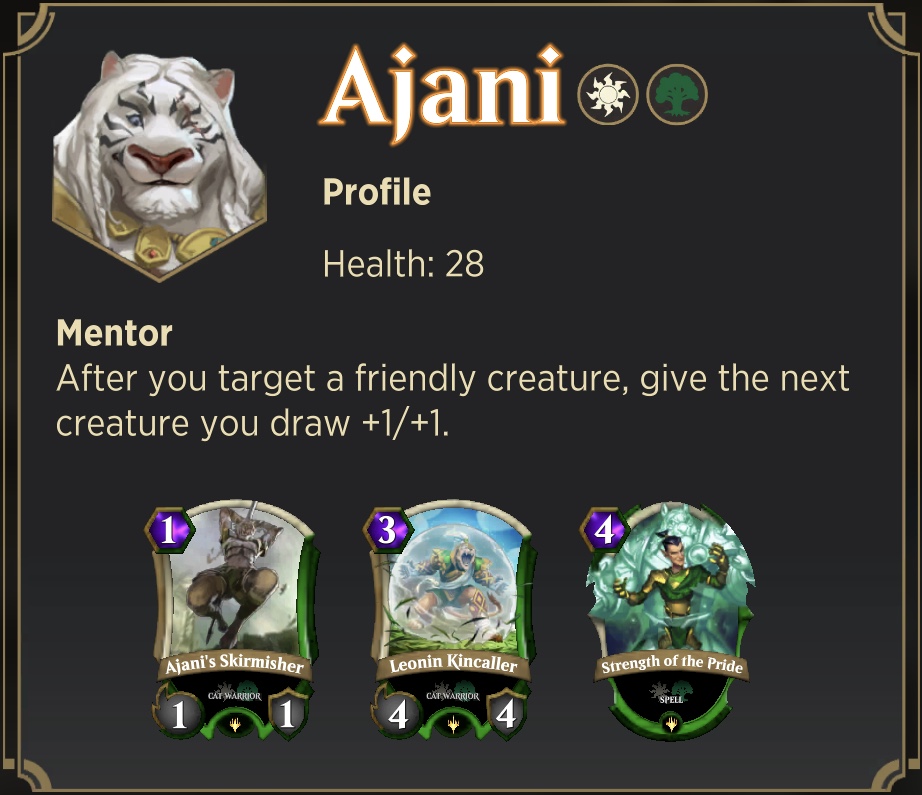
sooOOo buff
Ajani
Ajani is the definition of a midrange Slinger, rewarding you for targeted effects on your own creatures with delayed P/T buffs to your later creatures, incentivizing a classic “Voltron”-like approach with a studied balance of creatures and targeted effects.
Unique Traits
Ajani sports the game’s highest starting life total at a beefy 28, which both pays homage to the life-gain tendencies of his Magic Planesalker cards, and suggests that we’re building toward mid- to late-game payoffs with him here.
As we will see with most entries today, multicolored Slingers have a default deck construction rule of being limited to cards of either or both of their two colors, but allowing any number of each. No need to worry about splash slots as with all of last episode’s Slingers.
Ajani’s “Mentor” ability is straightforward on the surface: whenever you target a friendly creature, regardless of the targeted effect, Ajani stacks up another +1/+1 buff for the next creature you draw. When you do draw a creature, it will get all of the stackd Ajani buffs, operating sort of like an inverse of Ashiok’s ability further below.
Ajani’s Signature cards are relatively straightforward as well. Ajani’s Skirmisher is a 1/1 with trample that gets +1/+0 (permanently as usual) every time it’s targeted. Leonin Kincaller is a 4/4 that puts a copy of another target friendly creature on top of your library, both triggering Ajani’s ability and guaranteeing a creature draw to profit from it (which can “combo” with another copy of itself if you just want to draw a 5/5 every single turn). Strength of the Pride is a game-swinging spell that buffs two friendlies with +2/+2 each, granting two Ajani triggers.
The Buried Lede
The subtlest nuance to building around Ajani is the classic Voltron problem of deciding on a target (ayo) creature density. Whereas traditional Magic decks based around Auras, Equipments, or other buffs have to worry about drawing enough creatures to put their effects on — and avoiding the dreaded hand of “all clothes, no wearers” — Ajani’s ability adds an additional wrinkle that can actually make a (relatively) lower creature density profitable.
One approach to building Ajani is to build a very creature-dense list where many of your targeted effects come from creatures with built-in Debut, Attack, or Activate triggers — Devoted Steed, Elvish Infuser, Stoneforge Mystic, Aven Tour Guide — which sort of boils down to making nearly every creature you draw between +1/+1 and +3/+3 bigger. Another, perhaps subtler approach is to focus more on getting your triggers from Artifacts and Spells, thus lowering your creature count and stacking up more buffs to give a key creature something like +8/+8 or more.
In either case, you want to think about not just what kind of creatures grant targeting or benefit from the targeting you’re using, but also what creatures most benefit from the average buff stack you’re generating. Evasion and trample are obvious winners, and Ajani also makes an exceptional home for Fight creatures like Spearcrowned Stag and Brawling Behemoth. Less obviously, Ajani also does great work with creatures that want to survive through several of their own Attack triggers, like Leonin Warleader or Briarfox.
Of the Class cards currently available, Oath of the Paladin offers a bevy of obvious parallel synergies, giving you a guaranteed targeted trigger early; rewarding you for going wide-ish in the midgame; and helping you buff your whole team late.
However, while the first two cards of Circle of the Druid have no baked-in Ajani synergy, don’t discount the possibility of slamming a Wildshape Brontosaurus with +5/+5, making yourself nigh-unkillable against decks limited to damage-based red or green removal. Especially if you run some versatile Ward-granters like the GW staple Armadillo Cloak, this can be a viable way to catch your opponent off-guard and steal a few otherwise unwinnable games.
What to Watch Out For
The biggest, and potentially most frustrating, caveat is that Traps don’t trigger Ajani’s ability whatsoever. Because of the way Traps work in this game as basically “triggered instants,” none released so far actually target anything in their rules templating. As such, Ajani was already the green Slinger least interested in staples like Giant Growth, even before that card’s recent and not-insignificant nerf.
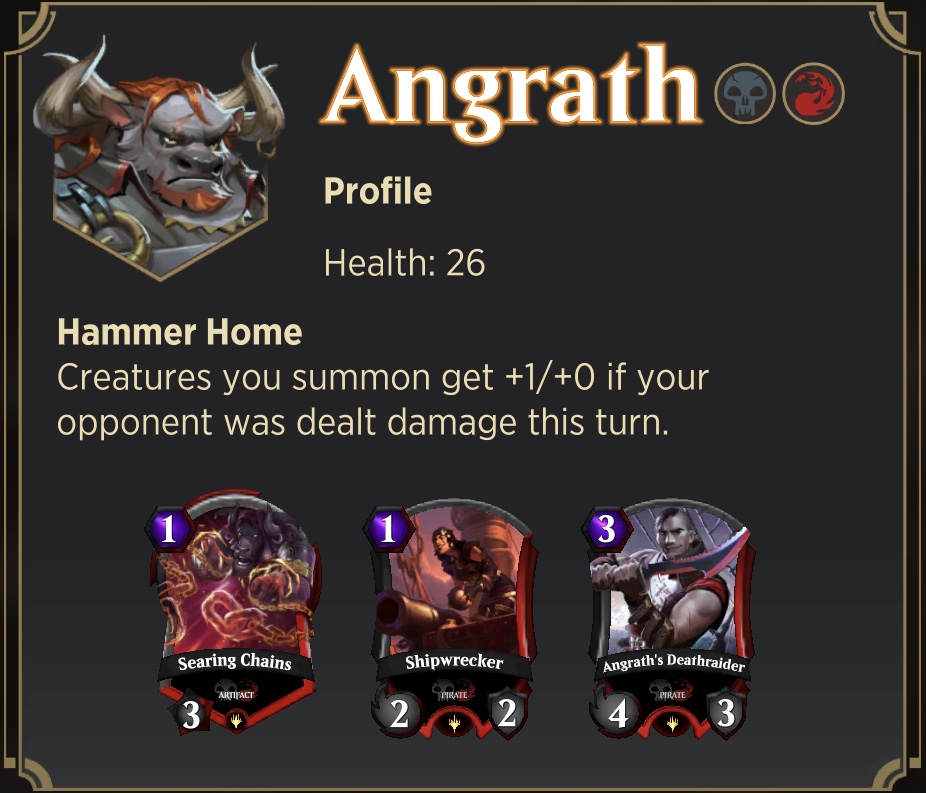
…not so buff
Angrath
Angrath is like a Bloodthirst general, incentivizing you for pushing through damage every turn possible and providing you with three unique tools for doing so.
Unique Traits
With a healthy 26 starting life and deck construction limited to red and/or black cards, Angrath’s “Hammer Home” ability grants +1/+0 to each creature you summon on turns where your opponent has previously taken damage this turn.
Crucially, note that Drain and other “lose life”-style effects in Spellslingers do count as “damage,” and also that Angrath’s wording opens the door for triggering even if the opponent takes damage from their own cards. This can be relevant if, for example, you run Traps that summon creatures during your opponent’s turn.
Angrath’s Signatures have been among the weaker ones in the game, so it’s not too surprising that two recently got significantly buffed. Searing Chains remains unchanged, a three-charge artifact for 1 that pings the opponent, enabling up to three Hammer Home triggers. Shipwrecker is a now a 2/2 for 1 that shocks the opponent when blocked, ensuring it gets you an Angrath trigger either way. Angrath’s Deathraider, a three-mana trampler buffed massively from 4/1 to 4/3, replaces itself with a draw on Debut if you have “Bloodthirst.”
The Buried Lede
I have to be brutally honest: so far in the Spellslingers public release, Angrath has been, in my humble opinion, fully the worst Spellslinger. I’m mildly optimistic that the Signature buffs will help him obtain a little more metagame share, as Shipwrecker’s problem at 1/2 was that it almost never traded across — and I stopped even running Angrath’s Deathraider before the patch, because at 4/1 it played more like an awkwardly timed Ball Lightning than a “real” creature.
What you probably want to be doing with Angrath is building around creatures that love to be buffed, like Two-Headed Hellhound and cost-efficient tramplers, flyers, and “sneakers.” If you want to build a very aggressive low-curve list, Hellmouth Cave is a land that frequently enough feeds these same creatures with a parallel source of +1/+0 buffs, though Molten Monastery’s card advantage is just as good here as in Chandra monored, and Active Volcano is actually a bit better than usual in a list that hopes to force combat damage on as many turns as it can.
The slightly underpowered Path of the Barbarian is probably at its most efficient in a deck like Angrath, which may justify experimenting with it over the generally better Pact of the Warlock, though the latter is also quite good given that Angrath’s creatures do tend to die during your own attack step quite often.
Surprisingly, though, the most impressive Angrath list I’ve seen has been a “Big Angrath” Old Graveyard build that appeared to essentially treat Hammer Home triggers as an afterthought, instead simply capitalizing on Angrath’s color pair to play Black-Red Control with a full suite of removal options like Pyroclasm, Infest, Lava Wave, Flagrant Foul, Drain Blood, Shock, etc — not to mention some of the best finishers in the game, with top-end like Spawning Hellion, Shivan Dragon, Grave Titan, and Inferno Titan to choose from.
What to Watch Out For
To be brutally honest, I just still don’t think Angrath is all that great. I would not be surprised if his buff ends up being pushed to +2/+0 down the road, not dissimilar to how Nahiri was buffed recently, which we’ll be discussing next issue.
My general caveat is that, although now is the time (if any) to again experiment with aggro and midrange Angrath lists, don’t throw out the idea of building some “gold” Slingers as just a color pair with a strong card pool, which we’ll be revisiting below with Teferi and again next installment with Kiora.
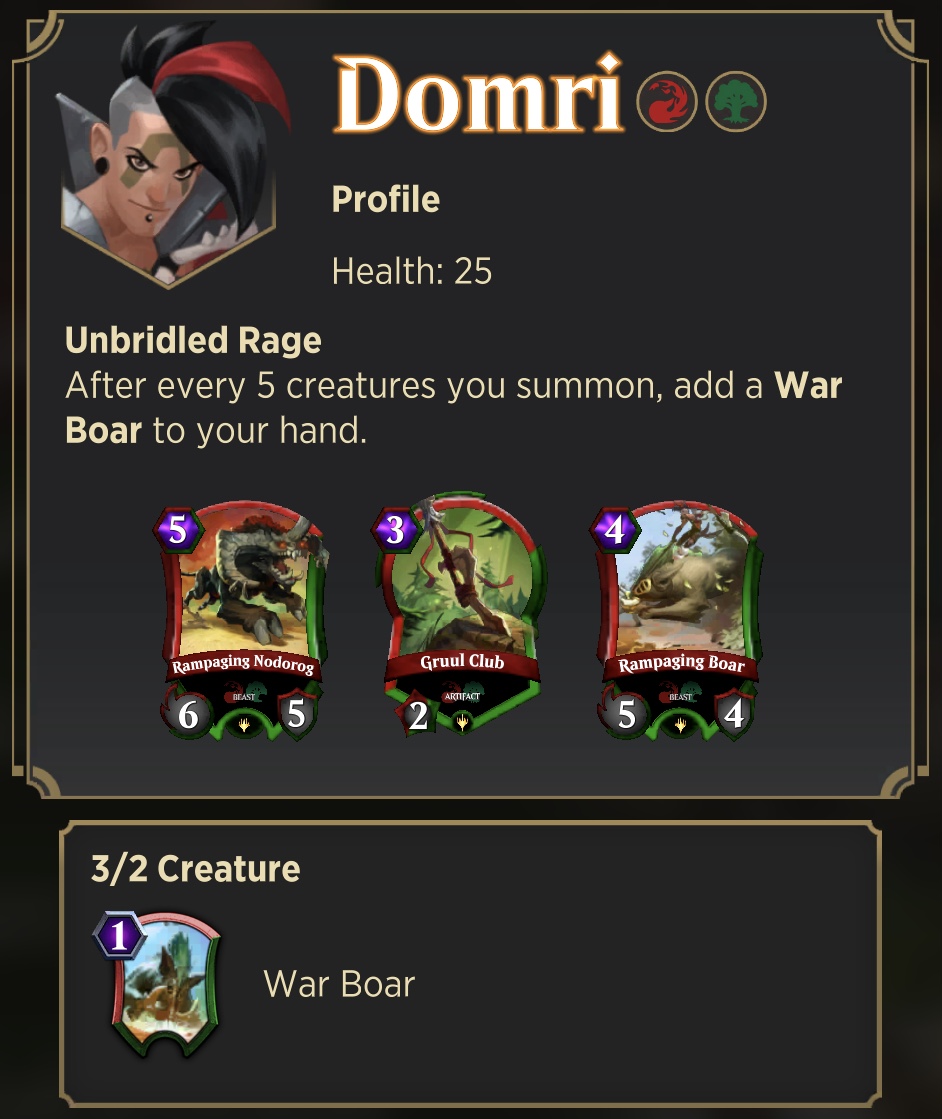
all the pigs are all lined up
Domri
One of the game’s premier aggressive and midrange Slingers, Domri offers card advantage and board position for nearly “free,” threatening to surprise the opponent with a sudden flood of creatures even when “Hellbent” and playing off the top.
Unique Traits
Domri has 25 starting life and a red-green card pool (shocking!), and his “Unbridled Rage” ability puts a 3/2 War Boar in your hand for every five creatures you summon. War Boars have been nerfed from 0 mana gems to 1, which I view as a welcome change to a Slinger who will still be plenty powerful even so. And casting your War Boar does tick up the creature counter, so you essentially only need to draw four “summon” sources per trigger, after the first.
Domri has two Signatures that directly augment his march of the pigs and one that’s just kind of like, “midrange lol.” Rampaging Boar is a 5/4 for 4 that gives your War Boars, current and future, +1/+1 in all zones this game. Rampaging Nodorog is a 6/5 for 5 and, similarly, grants your current and future death pigs your choice of trample or haste. Lastly, Gruul Club is a mystifying two-charge artifact for 3 that lets you make a friendly creature fight an enemy creature — of which I run one copy in my higher-curve Domri midrange list and zero copies of in my low-curve turbo-aggro Domri build.
The Buried Lede
The most important thing to keep in mind with Domri is that in Magic Spellslingers, unlike in Magic: The Gathering, every creature you put into play by any means counts as “summoning” in the same rules sense. This means that cards like Forest Patrol or the mighty Goblin Fieldrusher give you more than one tick at a time on Domri’s creature counter, while a few unusual cards like Mysterious Coccoon can give you one tick now and another later. Predator Ooze, one of the best midrange creatures in the game in my opinion, is extra potent for Domri because it can net you multiple summon triggers per game against either an inattentive or well pressured opponent.
My experience with Domri has been that, despite the signaling and incentives of literally all three of his Signature cards, he is at peak performance with an extremely low-to-the-ground “Stompy“-style shell that’s heavily focused on your ratios of P/T and summon triggers to mana spent. For this reason, I play my beloved “STOMPRY” list full of one-mana 0/1s and 0/2s far more often than my midrange “RG Monsters” list full of “good cards” and “removal.”
Notably, the latter style of Domri deck strongly favors the increased card flow of Molten Monastery, where midrangey or Big Domri lists are more likely to want Deep-Forest Arena. (I’ve seen some players run Gaea’s Cradle in Domri recently, but I don’t honestly see the benefit.) Domri Stompy is also an archetype where you care so much about early-game consistency that you very well might not run a Class card at all.
What to Watch Out For
Honestly, the biggest intrinsic problem for a well designed Domri list is that you can still only have five creatures on the table at any given time. This fundamental game design difference between Magic and Spellslingers inherently limits the threat and efficacy of go-wide strategies in the latter.
When you’re first getting used to Domri, it’s likely that more than once you’ll lose yourself in the excitement of your seemingly endless flow of threats, only to remember the hard way that casting a sixth creature forces you to sacrifice another — or that casting a spell like Forest Patrol over a full board does Actual Nothing.
As such, there are a surprising amount of paradoxical Domri scenarios where, when you’re either a little ahead or in a relatively even race or stalemate, where you’ll find yourself needing to “waste” mana and hold back creatures for next turn so that you’re getting the greatest “trade value” out of every card you’ve already cast. In this way, even turbo-agro Domri can find itself forced in the mid- or late game to shift from a “Sligh” value-per-mana focus to a more “Philosophy of Fire” value-per-card focus.
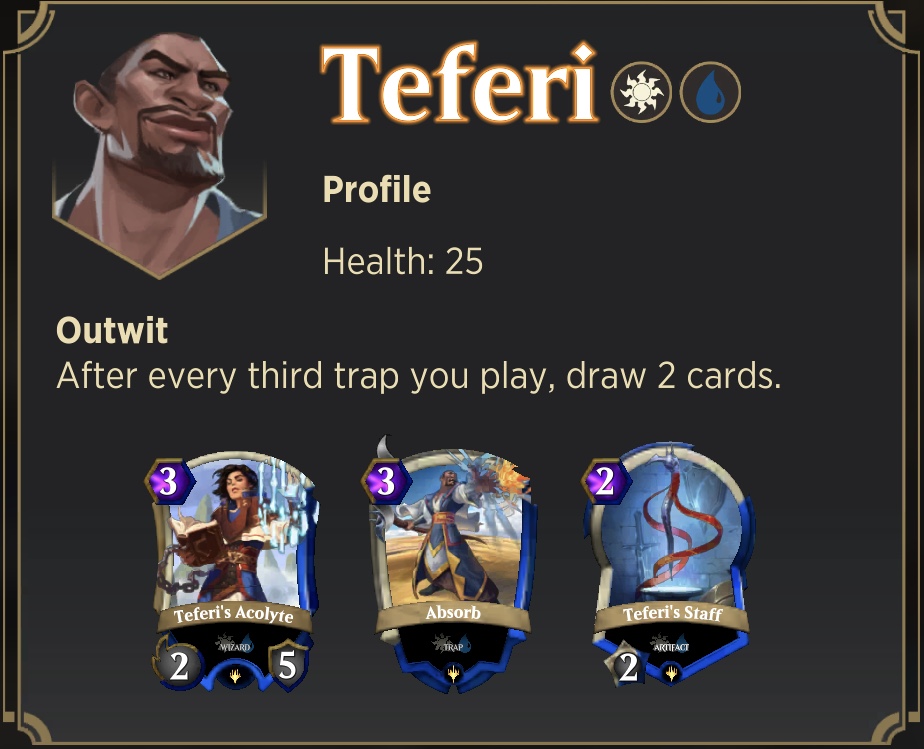
vv timey wimey
Teferi
With a triggered ability meant to captures the flavor of Magic‘s iconic time manipulator, Teferi emphasizes interaction in a unique set of ways and heavily highlights the game’s subtlest card type, Traps. Like them, Teferi is easy to spam, yet difficult to master.
Unique Traits
Teferi offers a blue-white card pool and opens with a respectable 25 life. His “Outwit” ability has been dramatically buffed, now granting two card draws (instead of one) for every third Trap you cast. Crucially, Teferi’s Trap counter goes up not when you arm a Trap, but when the Trap actually triggers — which does limit your agency a little bit, and perhaps informs what specific kinds of Traps you want to build him around.
Teferi’s Signatures all tie directly into the Outwit playstyle. Absorb is itself a three-mana Trap that, while armed, counters your opponent’s next card of any type that costs 3 or greater. Like Magic‘s Absorb, it also gains you 3 life. Teferi’s Acolyte is a defensive 2/5 for 3 that, on Debut, makes the next Trap you arm cost 0. While there are awkward moments where the Acolyte’s trigger only nets you a small benefit or none at all, it can also produce massive tempo swings when paired with impactful Traps like Call the Wind, Immolating Glare, or its best buddy Absorb.
The recent update to Teferi’s Staff is the most fascinating and exciting change in the patch update for me, because it’s neither a strict buff nor a strict nerf, but a true redesign. The Staff remains a two-charge artifact for 2 — but where it used to draw a random Trap from your library, similar to Magic Arena‘s Alchemy mechanic “Seek,” instead it now offers you a draft choice of three Traps from the entire card pool.
As we discussed last installment, draft effects like this one even allow you to pull in cards from outside your colors or splash restrictions. Teferi’s games going forward will be far more diverse and unpredictable (for both players), though that might come at some cost in terms of consistency for the timeboi.
The Buried Lede
There are a few difficult things baked into the task of building and playing Teferi.
One built-in challenge is that, by nature, Traps are a little unpredictable even for the player casting them, and there also…aren’t that many good ones so far. Some do offer inherent proactive value, like Call the Wind — or Wurm’s Wake, now that Teferi has a way to find one — but for the most part, Traps are interactive and conditional.
Cards like Negate or even Absorb can “whiff” for a whole turn or be played around by a careful opponent who knows the card pool well — and cards like Immolating Glare, as excellent as it is, can force you into awkward situations where you have no choice but to “arm up” even though you’re not sure what you’ll hit, if anything.
Going deeper, because of the interactive nature of Traps and the associations many players have with Teferi from MTG, it can seem natural to treat him as necessarily a control archetype. And certainly, you can build a very robust Blue-White Control list featuring some of the same tools we discussed last week for Jace. All of that is viable — and what Teferi loses compared to Jace’s late-game mana and library manipulation, he now gains in raw card advantage, on top of having unfettered access to the blue-white card pool.
And for the record, in any of the above configurations, you most likely want to run School of the Wizard — even though Traps have zero synergy with it — and probably Tolarian Academy to support your Staffs and Isochron Scepters, though Fountain of Magic, The Yawning Portal, and the massively improved Sacred Sanctum are viable alternatives.
However, where I’ve found the most success with Teferi — and by far had the most fun — is with an aggressive UW Tempo list that almost ignores his Outwit trigger. In that alternate archetype I run a variety of disruptive creatures like Mana Constrictor, Frost Lynx, and Mist Raven; last week’s aggressive package of Untested Rookie, Shields Up, and Beginner’s Luck; and efficient evasion like Welkin Tern, Phantom Warrior, and Call the Wind.
As it turns out, once you throw in some Traps that are just plain amazing, like Absorb and Immolating Glare, this approach can even still pop off a Teferi trigger or two each game. Now that Teferi’s Staff has the potential to get aggressive off-color Traps, I plan to test whether it’s right for this shell, which also runs Oath of the Paladin and Training Yard rather than a more controlling land or Class.
And of course, though he lacks Gideon’s aggression or Jace’s Apprentice, Teferi can be a natural for the build-around Fair Fight deck. Where the Jace and Gideon builds make more sense when Paragon of Balance-centric, Teferi’s access in blue and white mean that he can get away with running more Fair Fight-centric cards like Blink Dog Pack, Regna, or Team Captain, which might not feel worth a splash slot to Jace or Gideon. Lastly, Fair Fight’s best friend in every way is, of course, Oath of the Paladin.
What to Watch Out For
Another thing you need to be vigilant about is the very real threat of decking. While the decking rule in Spellslingers gives you until the end of turn once your library is empty, I had already decked myself with Teferi once or twice even before his trigger effect was doubled. In short, unless your Teferi Control list is unusually Trap-light, you probably don’t need to run more card-draw than a pair of Divinations or one Wizard’s Spellbook.
This problem could get a little worse going forward, as the recent Ashiok nerf may push more Ashiok players toward the mill-focused version to get more Nightmares to trigger per game. Speaking of which…
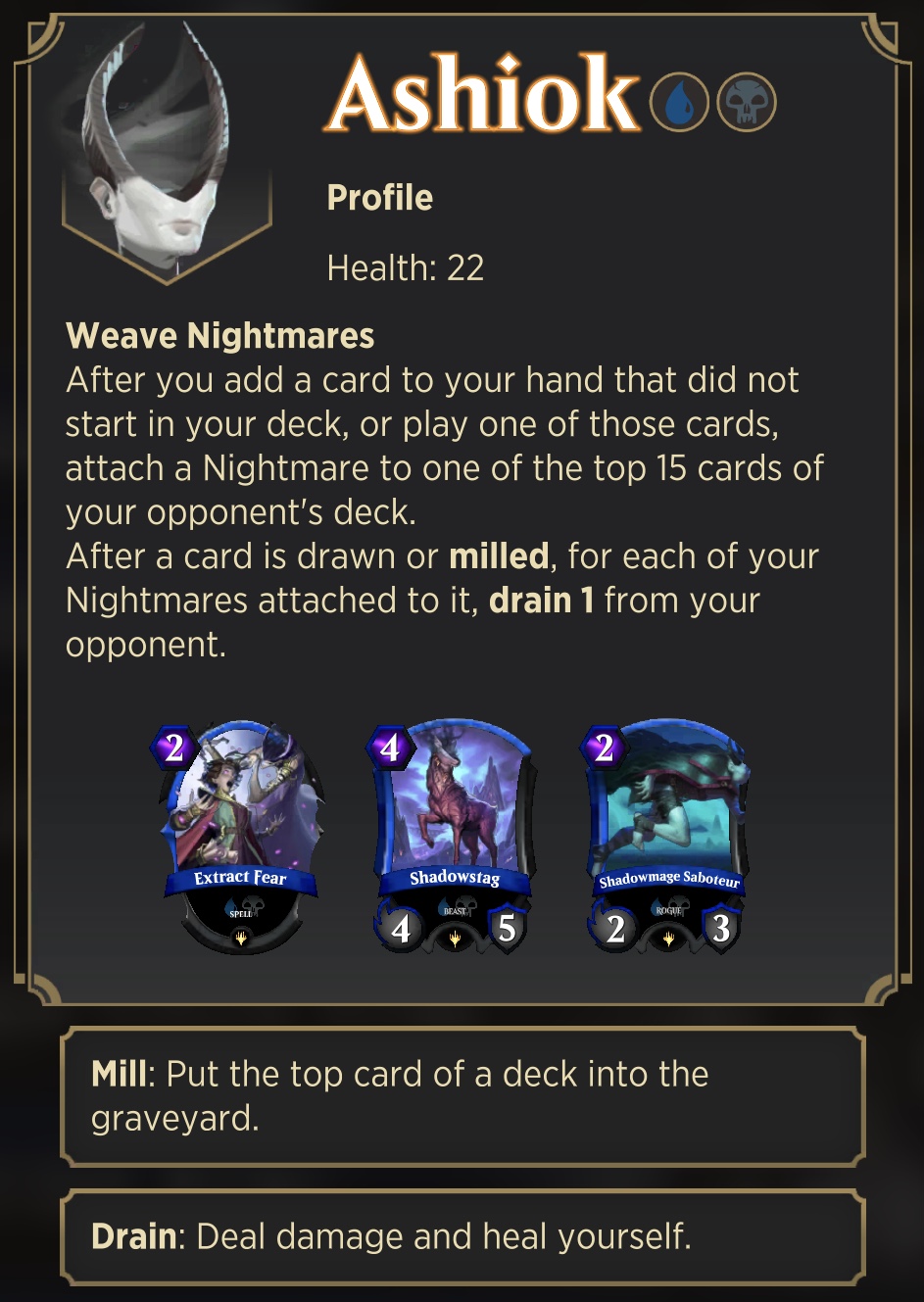
iconic they/them twink top energy
Ashiok
Featuring a complex, unique long-term setup mechanic that incentivizes you to drag the game out and “create” cards as only a digital card battler can, Ashiok is in many ways the game’s premier control Slinger — and its most frustrating to play against.
Unique Traits
Ashiok has two spoOoOooOky qualities: access to the entire dark, mysterious blue-black card pool; and a terrifying starting life total of just 22, the lowest in the game.
The reason for the latter detail, however, is the absurd amounts of late-game life gain generated by their “Weave Nightmares” ability. Whenever a card that did not originate in your starting deck is added to your hand, and also whenever you play such a card, Ashiok “attaches a Nightmare” to one of the top 15 cards of your opponent’s deck at random. Then, whenever a card is drawn or milled from their library, Ashiok drains them equal to the number of Nightmares attached to that card.
Woof! What a mouthful, right? Though it’s probably for the best, I’m sad to say that the 1.01.02 nerf from “top 10 cards” to “top 15 cards” is extremely significant. The crucial moment in a non-mirror Ashiok matchup is when the average Nightmares-per-draw starts approaching 2. Where 15 Nightmares in the deck used to feel like a tantalizing “we’re almost there,” it now feels more like a demoralizing “I’m just getting started?!”
Ashiok’s Signatures are a mixed bag of absolutely incredible and all-too-credible. Extract Fear, nerfed up to cost 2, lets you draft a card from your opponent’s library, which diversifies your plays and gives you information on their build all while spitting out a Nightmare. Shadowmage Saboteur, a 2/3 for 2, doubles all your Nightmare production for the rest of the turn after it attacks — which is more essential to Ash’s game plan than ever, and forms the bedrock for all of their most inescapable routs.
Then there’s Shadowstag. It’s a 4/5 for 4 that on Debut makes all not-from-your-starting-deck cards in your hand cost 1 less. While there are situations where your hand can get clogged up with created cards you don’t have the mana to optimize, spending four whole mana gems on a clunky 4/5 is rarely going to feel like the solution; and ironically, Shadowstag is actually at its best when you have a bunch of 2s and 1s you can turn into 1s and 0s. Given this inherent paradox, you should probably never run more than one Shadowstag, and I do not run it at all.
The Buried Lede
Like Jace and Teferi, Ashiok is a deep, complex archetype with a steep but rewarding learning curve. The first thing I’m going to say is this: just because it plays like control doesn’t mean you don’t have to think about your mana curve.
If anything, Ashiok is the non-aggro Slinger who demands the most attention to curve and mana efficiency. On some level, yes, your task is to find the best tools for stalling the game out long enough to drain your opponent of, like, 30 life in scaling increments — but none of that means anything anyway unless you are generating as many Nightmares per mana, per turn, and per card as (in)humanly possible.
When I raised this observation to former Magic designer Zac Hill, he concurred and even went as far as to describe Ashiok as a Philosophy of Fire deck.
It’s for this reason that the Extract Fear nerf hurts. It’s also why, unlike many Ashiok players, I don’t run any of the colorless ‘Bots beyond the two-mana Neurobot and their blue Wizard cousin Lorekeeper. I feel that three mana or greater is simply too much for a card that only generates one Nightmare, unless that card is also serving an essential control function like removal. When it comes to cards that don’t generate Nightmares at all, I limit those to absolute essentials; e.g., I do run both copies of Infest, the best “small” board wipe in the game, but I do not run Divination, Unsummon, etc.
An important thing to understand about Ashiok’s game plan is that it is the pinnacle of what Magic players call “inevitability.” If you just sit back and don’t apply pressure to Ashiok, just by being Ashiok they will inevitably overwhelm you with life drain that puts any hope of killing them out of reach at the same time it’s actively killing you. This means that against Ash, you need to be at your most aggressive, even if you’re in a controlling archetype yourself; someone is always the beatdown, whether you like being forced into that role or not.
This dynamic is exacerbated by the fact that Nightmares deal Drain and not just damage. Every Nightmare awakened represents a two-point life swing, and part of Ash’s inexorable tide of inevitability is the fact while almost every deck deals some amount of damage, Ashiok always gains life too. Decks with no means of life gain of their own, that fail to overwhelm Ash with pressure early enough, eventually cross a threshold they simply cannot come back from.
Ashiok’s completely unique mechanical structure also gives them unique benefits from the function of many relevant lands; the entire Class card type; and many if not most of the game’s time-limited Events, where Ashiok is quite often the dominant choice. The obvious Class for Ashiok is School of the Wizard, with an amazing ultimate and a second-level card that generates two Nightmares for 2 on top of being a great draft “tutor.” Fountain of Magic and Old Graveyard both offer clear synergy on top of their baseline card advantage, though The Yawning Portal has some special benefits I’ll mention in the next section, and Refreshment Stand is fine if it’s what you have.
What to Watch Out For
Ashiok is kind of a Unique Problems Generator.
For all the card types and situation that uniquely favor Ashiok, there are also a few drawbacks. When your Ashiok opponent opens with a Class card, pay attention to their draw steps: when you see a Nightmare generate at the very start of their turn, you know they’ve drawn the next card in the sequence. The same lens can be applied if they run anything that creates new cards in the library later in the game, as with Arcanis, the Archmage. On the flipside, if you’re Ashiok, be aware that your draw step reveals this information to attentive opponents.
Back on the bright side, draw-heavy Slingers like Teferi and Jace are at an inherent disadvantage against Ashiok. If post-nerf Ashiok’s “true” starting life total is around 30 where it used to be closer to 40, then against Jace or Teferi it’s likely to be around 35. And to be clear, that’s my way talking about just the “automatic” Nightmare drains the Ash player gets by default, even if they’re not playing especially well or aggressively.
Ashiok mirrors are miserable. Straight-up. And relevant to the discussion above around mana efficiency and the Philosophy of Drain, Ashiok mirrors are quite simply decided by who spits out the most Nightmares fastest. If either play lands a Shadowmage Saboteur that goes unchecked for more than one attack — and sometimes even one attack is more than you can allow — then that is the player who is going to win, unless the rest of their hand is somehow absolute awkward jank while the Saboteur lives.
In part for this reason, The Yawning Portal is my Ashiok land of choice. In addition to occasionally generating a high-impact card plus a Nightmare, and preserving your late-game mana development, it also serves as a modest and low-cost anti-Ashiok tech because it actually replaces your normal draw from library. I won’t go so far as to call it the Ashiok mirror breaker — but when it triggers multiple times a game, or when the drain-race rages on while both players are at low life, it can be game-deciding.
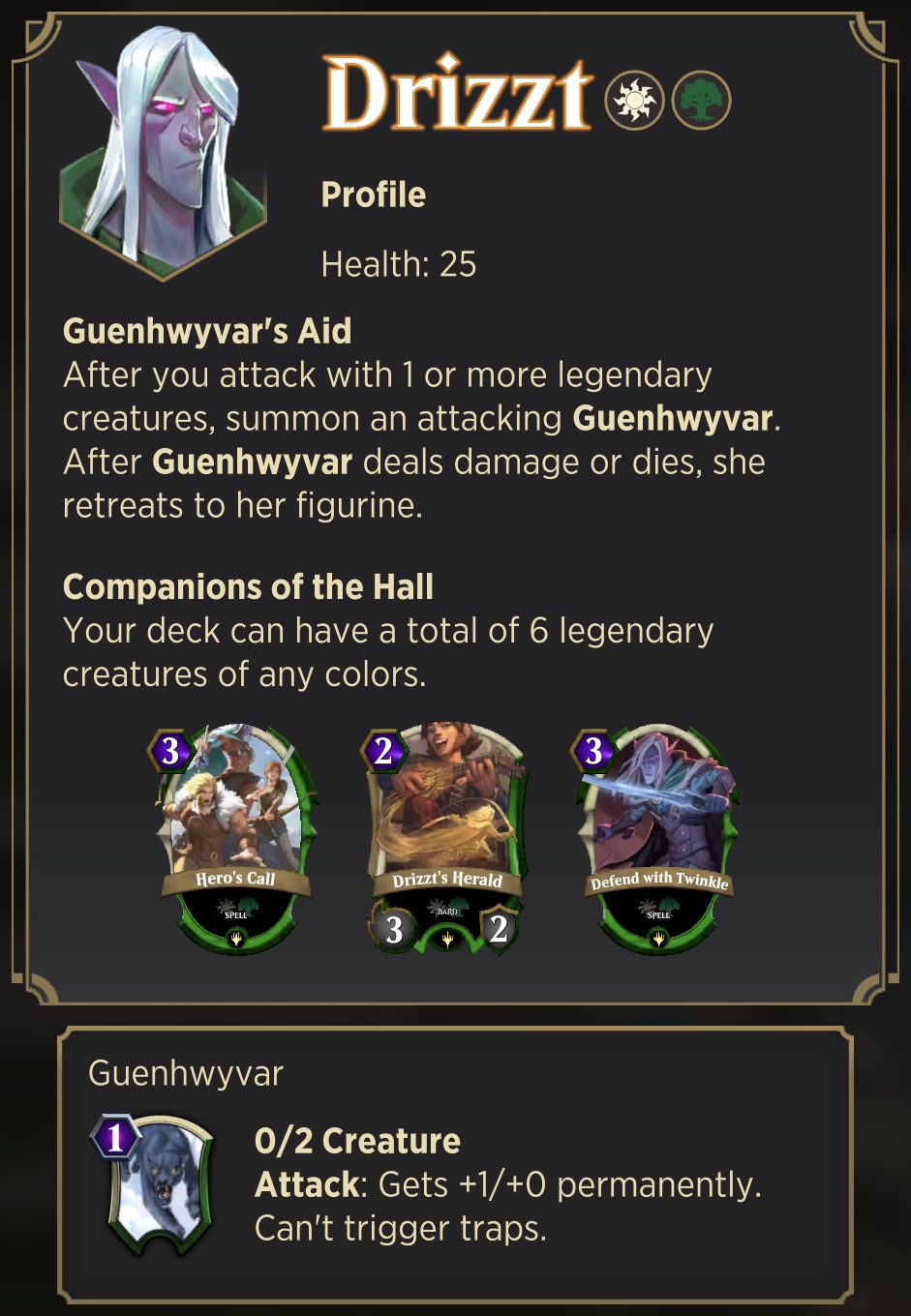
love the idea of a bard singing that they’re cool and famous so hard they get cool and famous
Drizzt
Introduced alongside the D&D Icons mini-expansion and quickly rising to nerf-worthy dominance, Drizzt has brought to the game a whole new approach to both aggressive and controlling midrange deckbuilding with a fun, flavorful Legendary twist.
Unique Traits
Drizzt starts with a nice normative life total of 25, but unlike all the other multicolored Slingers on this page, he actually has a deck construction ability: “Companions of the Hall,” similar to Vivien’s “Nature” ability, means that in addition to full access to the green-white card pool, Drizzt can run “a total of 6 legendary creatures of any color.”
As liberating a pile of splash slots as that is, so it is a restriction: the word total is the clue that signals that even green and/or white legends will count against this limit. So ironically, even plain old green-white Ajani can run more legendary creatures than “the legendary-matters Spellslinger.”
The reason for this is Drizzt’s other ability and centerpiece, the unpronounceable “Guenhwyvar’s Aid”: whenever ol’ Drizzy attacks with one or more legends, he summons a Gideon-like temporary attacking cat “token”. The cat starts as a 0/2 before triggering and gets +1/+0 each time, meaning it attacks as a 1/2, then a 2/2, etc. Before the much-needed nerf, this kitty also had trample, which made it all too easy for Drizz to close out games regardless of board state.
Drizzy’s Signatures all interact with this core idea, though some of the synergies at play are less than obvious. Drizzt’s Herald is a 3/2 for 2 that makes a friendly creature legendary. It just…makes it legendary. This enables said creature, which can be the Herald itself, to trigger a cat attack; the assignment of legendary as an arbitrary status also has no mechanical drawbacks — because in Spellslingers, “legendary” is just a limitation on deck construction, not board states. If you cast Ebondeath while your opponent has one in the ‘yard, you can just have two Ebondeaths out.
Hero’s Call is a three-mana spell that lets you draft from a choice of three random legendary creatures and then reduces the drafted card’s cost by 2. As good and sometimes game-altering as this can be, I personally run just one copy of this card, and I have a rule of always replacing it when it appears in my opener. You just never want this card until you want this card.
The subtlest and most defining Signature is the nerfed-but-still-great Defend with Twinkle. For 3 mana, this Spell gives a friendly creature +0/+2 and Ward, then generates its sister card Strike with Icingdeath, which does kind of the opposite for the same cost: it stuns an enemy creature, and gives a friendly +2/+0. In addition to telling the flavorful story of a block-strike combo with (I think) a dagger and blade, this offers subtle synergy by helping to make sure you can attack with your crucial legendary creatures — first by making sure they survive at least a turn, and then by giving you selection over what you’re attacking into.
The Buried Lede
When Drizzt launched, the player base solved the new metagame quickly. The choice of legendary creatures quickly moved away from big, obvious, high-cost bombs in favor of legends with either evasion, extreme mana efficiency, and most importantly, haste. As with Gideon, Plan A became “trigger the cat as early and often as possible” — which also means doing everything you can to preserve the board position that makes that possible, whether that means Giant Growth or Shields Up or Grudge Match or Path to Exile or Immolating Glare, all of which appear together in many Drizzt lists.
The stars of the show quickly turned out to be a few key four-mana speed demons in Inferno, Tajic, and Zo-Zu — as well as Drizzy’s D&D compatriot Karazikar, the Eye-Tyrant, whose combo of flying, ward, and four alternating Rays packs quite a punch and makes him much cooler than his straight Magic version, Karazikar, the Eye-Tyrant.
Players also quickly discovered the value in one-mana legends Matron Malice and Pir, the Dreamer — the cat token triggers his ability, so he never attacks as less than a 1/2 in Drizzt — and Yeenoghu, Beast of Butchers, who can either be treated as a late-game fireball when necessary, or facilitate ridiculous Birds of Paradise God-hands that give you a 4/4 or 6/6 legendary attacker with trample and haste as early as turn 2 on the play or turn 1 on the draw.
Although the nerfs have knocked Drizzt down from solo status in the S-tier to A- or B-tier status, I feel that his explosive debut on the scene has taught us a lot about the deeper layers of gameplay and deck construction. I never saw a single player running Gladecover Warden before it arose as tech for keeping Drizzy’s legends alive, but now I run it in decks like Aggro Ramp Nissa; similarly, I didn’t think Deep-Forest Arena was that special before Drizzy showed us how to maximize it. But even after it got nerfed for doing so, it continues to protect midrange and late-game threats as the land of choice for the vast majority of green decks.
Lest I give you the impression that the Drizz can only be built as an aggro midrange archetype, I want to shout out EpicCandyPanda from the Hipsters Spellslingers Team. Panda was the first player on our team to make Mythic, fighting their way as high as 88th in the world at one time, with the help of a more controlling Drizzt build that included curveball removal cards like Retaliate that other players simply overlooked.
What to Watch Out For
A few interesting corner cases and templating lessons arose from the Drizzt Age as well. One is the aforementioned Pir synergy, which makes Pir uniquely threatening with an always-buffed power on attack.
Another big one to watch out for is that, yes, even the Guenhwyvar cat “token” counts as “summoning” a creature. Where this can create some occasional feel-bad moments of surprise or forgetfulness is with Deep-Forest Arena: if the Arena triggers on your turn and you don’t summon anything before attacking with a cat trigger, the cat steals your Deep-Forest buff, and it doesn’t get to retain that buff in the future. On the flipside, this can be a way of pushing through more damage or better “trades” with your cat — or of getting some value out of your Arena trigger when you either have no relevant plays in hand, or when the Arena trigger itself screws your mana from being able to cast what you intended to that turn.
And that’s Part III!
These things take me a ridiculous amount of time to write, so don’t expect any kind of clever or effortful conclusion. You can also take this as a mild to moderate guilt trip in favor of passing this series along to your Spellslinging friends and Team members!
In the next installment, we’ll go over the multicolored Spellslingers of enemy color pairs, in, yeah, This Much Detail™. See you next time.
SINISTRA BLACK (she/her) is a Los Angeles-based writer-director, Transgender Anarchist killjoy, Void Witch, and war boar.
She publishes media essays and an email newsletter on her homepage, EASY ANSWERS. She can also be found on Twitter, Facebook, and other platforms, sharing humor, criticism, scorching takes, and searing (tweet)chains.
She is available for hire or deathraiding, but you better extract your fear.

